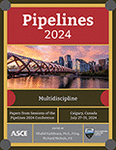Investigation of Circumferential Soil Pressure Distribution on a Buried MDPE Pipe Bend
Publication: Pipelines 2024
ABSTRACT
The structural analysis of buried pipelines largely depends on the circumferential soil pressure distribution around the pipe, as the lateral and axial soil resistances are a function of the soil overburden load. In the current industry practice, the pipe–soil interaction is represented using three orthogonal springs where the soil resistance is defined using the design guidelines. These guidelines were primarily developed based on steel pipelines. However, the effect of circumferential soil pressure distribution around medium-density polyethylene (MDPE) pipe, and thereby, the soil resistance to the pipeline can be very different as the soil load depends on the pipe’s relative stiffness and the soil’s shear strength parameters. The normal stress on the pipe surface, applied during conventional beam-on-spring analysis, is influenced by the pipe–soil interaction, which should be accounted for properly evaluating the pipe performance. This study investigates the normal stress on the pipe surface for buried MDPE pipe bend using finite element (FE) analysis. Plane strain analysis is used to investigate the stresses within the straight portion of the pipe, and three-dimensional analysis is performed to examine the stresses near the bend. Comparisons are shown for the FE analysis of straight pipe, pipe bend, and plane strain analysis results. It is seen that plasticity develops due to the presence of a stiffer element (pipe) in the soil medium, which may affect the soil stress distribution and, thus, the pipeline stress response. A pipe bend with a stress intensification factor and flexibility factor equal to one is assumed to behave similar to a straight pipe. This study shows that the soil stress around a bend and straight pipe differs. The effect of pipe presence in soil on the calculation of stress increase due to surface load is also shown in this study. A conceptual methodology is proposed to use a shell-spring-based finite element model to investigate the pipe stress due to traffic load. Using the normal soil stress distribution around a pipe, the in situ stress is idealized from the 2D plane strain or 3D continuum model. This in situ stress around the pipe is applied to the shell model. Then, the stress increased due to a traffic load using the Boussinesq theory is calculated and applied to the shell model in the next analysis step. The soil resistance is idealized based on American Lifelines Alliance (ALA) design guideline spring.
Get full access to this chapter
View all available purchase options and get full access to this chapter.
REFERENCES
ALA (American Lifeline Alliance). (2001). “Guideline for the design of buried steel pipe.” Accessed February 14, 2019. https://www.americanhttps://www.american llifelinesalliance.com/Products_new3.htm.
Dassault Systems. (2019). ABAQUS/CAE user’s guide. Providence, RI: Dassault Systems.
Helwany, S. (2007). Applied soil mechanics with ABAQUS applications. John Wiley & Sons.
Hardin, B. O., and Black, W. L. (1966). “Sand stiffness under various triaxial stresses.” J. Soil Mech. Found. Div. 92 (2): 27–42.
Hoeg, K. (1968). “Stress against underground cylinder.” J. Soil Mech. Found. Eng. 94 (4): 833–858.
Janbu, N. (1963). “Soil compressibility as determined by oedometer and triaxial tests.” In Vol. 1 of Proc., European Conf. on Soil Mechanics and Foundation Engineering (ECSMFE), 19–25. Essen, Germany: German Society for Earthworks and Foundations.
Lester, G. H. The Pipe/Soil Structure - Action and Interactions, Chapter 4 in Corrugated Polyethylene Pipe Design Manual and Instalation Guide, 2008.
Marston, A., and Anderson, A. O. (1913). The Theory of Loads on Pipes in Ditches and Tests of Cement and Clay Drain Tile and Sewer Pipe. Bulletin 31, Iowa Engineering Experiment Station, Ames, Iowa.
Muntakim, A. H., and Dhar, A. S. (2021). Assessment of Axial Pullout Force for Buried Medium-Density Polyethylene Pipelines. Journal of Pipeline Systems Engineering and Practice, 12(2), 04020074.
PRCI (Pipeline Research Council International). (2017). Pipeline seismic design and assessment guideline. Chantilly, VA: PRCI.
Robert, D. J., Rajeev, P., Kodikara, J., and Rajani, B. (2016). Equation to predict maximum pipe stress incorporating internal and external loadings on buried pipes. Canadian Geotechnical Journal, 53(8), 1315–1331.
Spangler, M. G. (1941). The Structural Design of Flexible Pipe Culverts. Bulletin 153, Iowa Engineering Experiment Station, Ames, Iowa.
Watkins, R. K., and Anderson, L. R. (2000). Structural Mechanics of Buried pipes. CRC Press, New York.
Information & Authors
Information
Published In
History
Published online: Aug 30, 2024
ASCE Technical Topics:
- Buried pipes
- Continuum mechanics
- Dynamics (solid mechanics)
- Engineering mechanics
- Geomechanics
- Geotechnical engineering
- Infrastructure
- Material mechanics
- Materials engineering
- Pipeline systems
- Pipes
- Pressure (type)
- Pressure pipes
- Soil dynamics
- Soil mechanics
- Soil pressure
- Soil properties
- Soil stress
- Soil-pipe interaction
- Solid mechanics
- Stress (by type)
- Stress analysis
- Structural analysis
- Structural engineering
Authors
Metrics & Citations
Metrics
Citations
Download citation
If you have the appropriate software installed, you can download article citation data to the citation manager of your choice. Simply select your manager software from the list below and click Download.
